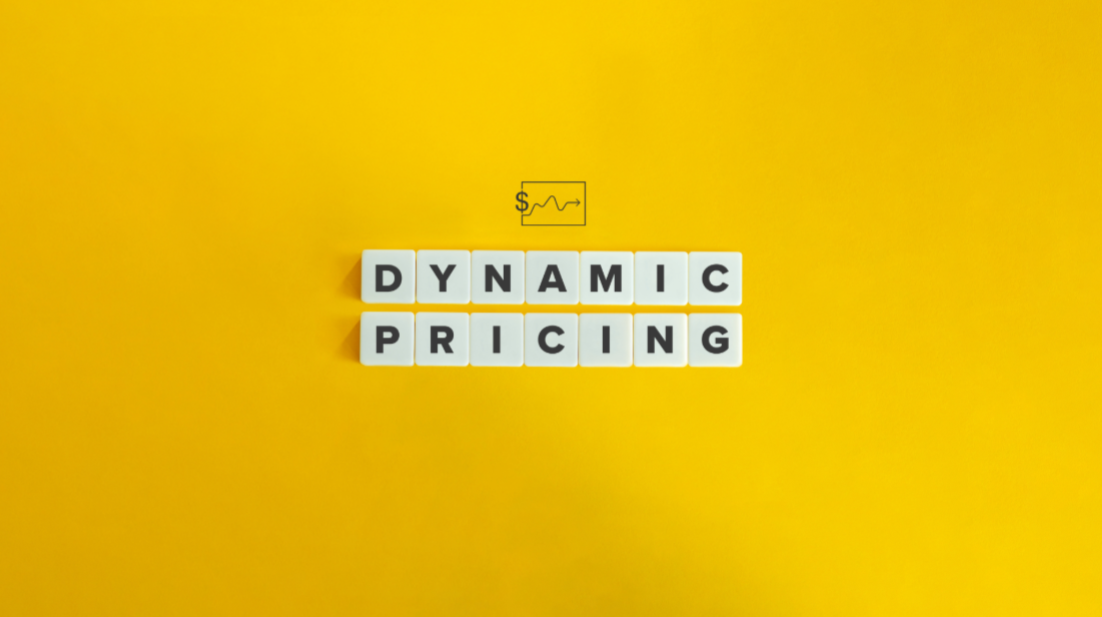In the competitive world of SaaS, dynamic pricing optimization with AI can significantly increase revenue. With this strategy, prices constantly adjust based on various factors, including customer behavior, competitor actions, and economic conditions.
Let’s explore the intricacies of dynamic pricing optimization with AI and discover how it can enhance your business operations.
Unlocking the Power of AI-Driven Dynamic Pricing

Have you ever noticed how airline ticket prices skyrocket during peak holiday seasons or how ride-sharing services increase fares during rush hour? That’s dynamic pricing in action. Dynamic pricing with AI is used by many financial institutions seeking more than just basic price optimization.
How AI Elevates Dynamic Pricing
Artificial intelligence (AI) has revolutionized dynamic pricing. Instead of manually adjusting prices, AI algorithms analyze vast amounts of data to determine optimal price points. These AI algorithms consider factors such as revenue targets and product markdowns to determine the ideal price.
AI-powered dynamic pricing solutions are significantly more advanced than traditional “if-then” rules. These systems automatically analyze competitor products, considering features, specifications, and customer reviews. They enable businesses to adjust prices based on market demand and customer preferences. With comprehensive data analysis, AI algorithms gain insights from market trends.
Here are some benefits of using AI for dynamic pricing:
- Personalized pricing for different customer segments, allowing for targeted discounts and promotions.
- Increased revenue by capitalizing on periods of high demand.
- Improved inventory management and forecasting by analyzing customer buying cycles.
- Agile pricing strategies that respond rapidly to competitor moves.
- Scalable pricing processes that eliminate manual intervention.
Industries Thriving on AI-Driven Dynamic Pricing

Companies across various industries are increasingly adopting dynamic pricing strategies using AI. Businesses are embracing AI pricing models to optimize their pricing strategies.
Here are some notable examples:
E-Commerce and Retail
E-commerce giants like Amazon use dynamic pricing extensively, constantly adjusting prices based on factors like demand, competition, and inventory levels. AI-powered pricing solutions have a significant impact on e-commerce, particularly for direct-to-consumer (DTC) brands. Dynamic pricing AI allows retailers to personalize promotions and optimize pricing in real-time.
Travel and Hospitality
Airlines, hotels, and rental platforms utilize AI algorithms to implement dynamic pricing strategies, adjusting prices based on factors like seasonality, demand, and competitor pricing. Dynamic pricing is especially prevalent in the travel and hospitality industry, with companies using AI algorithms to adjust prices based on factors like the day of the week, special events, and even property photos. A Swiss ski resort in Zermatt successfully implemented a pricing solution that led to an 8% increase in ticket revenue, highlighting the effectiveness of dynamic pricing solutions.
Ride-Sharing Services
Companies like Uber and Lyft employ surge pricing, a form of dynamic pricing, where prices fluctuate based on real-time demand, driver availability, and traffic conditions. AI algorithms play a crucial role in ride-sharing services, constantly analyzing demand patterns and adjusting prices accordingly. This real-time pricing approach optimizes revenue based on localized demand analysis, especially during peak hours.
Taking Your Business to the Next Level: Steps to Dynamic Pricing Optimization

Dynamic pricing optimization with AI is not just a passing trend; it’s a strategy that sets top performers apart. Here’s how to get started:
Define Clear Objectives
Before implementing dynamic pricing, it’s crucial to define specific objectives. Determine what you want to achieve—whether it’s increased revenue, improved inventory management, or enhanced market share. This clarity helps build a tailored dynamic pricing engine that aligns with your overall pricing model. Clearly defined goals from the outset enhance the likelihood of success.
Harness the Power of Data
Data is the foundation of successful dynamic pricing. Analyze your current pricing approach, identify key variables, and uncover potential profit opportunities. Dive deep into customer behavior, sales data, market trends, and competitor analysis. The quality and comprehensiveness of your data directly impact the effectiveness of your AI algorithms. The more information you provide, the more intelligent your pricing engine becomes. AI systems utilize machine learning models to create dynamic pricing strategies.
Embrace Agility and Experimentation
Don’t be afraid to experiment with dynamic pricing. Start small by implementing price rules, testing promotions, and analyzing the impact on your bottom line and customer experience. Set clear margin boundaries to mitigate risks. Regularly monitor analytics to understand how pricing changes affect your business. AI for dynamic pricing optimization offers immense flexibility, allowing you to tailor strategies based on real-time feedback.
Build a Framework
Machine learning plays a pivotal role in dynamic pricing, enabling businesses to leverage advanced analytics and predictive modeling. By analyzing historical data, market conditions, and customer preferences, machine learning algorithms can estimate optimal price points. This data-driven approach ensures that pricing decisions are based on comprehensive insights. Businesses can create accurate pricing models by utilizing machine learning algorithms and considering factors such as customer demand, market dynamics, and competitor pricing strategies. Here is a further breakdown of the different components that should be factored in:
| Component | Description |
|---|---|
| Data Sources | A large data set from varied data sources that encompasses areas such as inventory levels, sales trends, seasonality, economic trends, market data, and competitive pricing models that could even utilize external API data points. |
| Data Pipelines | Processing, scrubbing and cleansing the data so it can be organized for AI input. This typically involves using ETL methodologies, that are commonly used across several technology-based applications. |
| Embeddings | Utilizing a transformer model such as OpenAI, Google, Meta or Cohere that analyzes textual data into vectors which allows an AI model to accurately make assumptions based on its internal language models. |
| Vector Database | Pinecone, Weaviate, and PGvector are examples of databases that save and retrieve AI-based vectorized embeddings in a fast way. These allow for enhanced recall abilities when processing vast sets of information. |
| API & Plugins | Serp, Zapier, and Wolfram are popular AI-based services that streamline connection to several additional sources of information such as connecting to other databases. They can even help manage workflows and automate complex steps for speed and efficiency. |
| Orchestration | Services like Zbrain automate the ingestion and execution of external data sources while connecting them to the core AI application by dynamically routing the input variables in a highly logical fashion to accelerate execution. |
| Query Execution | Pricing teams that need insight will execute their request through the custom built dynamic pricing application allowing it to handle those needs quickly. These requests often center around issues, pricing recommendations and inventory adjustments. |
| LLM (Large Language Model) Processing | This is where the core language models and AI brains do their thing. Tools such as ChatGPT from OpenAI, Bard from Google or even Anthropic LLM can then create responses based on user inputted query execution, external APIs and orchestration. These are then intelligently displayed in the dynamic pricing app. |
| LLM (Large Language Model) Cache | By using an in-memory data store such as Redis or SQLite to intelligently store previously analyzed queries, results are generated faster the second time they are accessed as opposed to having to use a complete regeneration with the full Large Language Model. Tools like GPTCache excel in this. |
| Validation Layer | For ensuring accuracy and quality control, validation tools help make sure the LLM generated data is within the predefined specifications set by engineering or development. Some top validation frameworks include Guardrails, Guidance, Rebuff and even LMQL. |
| Logging & Monitoring | MLflow, Helicone, PromptLayer and Weights & Biases excel at handling the complexities and oversight required for any large language model driven app to make sure that everything is working at its best, while logging the most useful insights for analysis. This makes any app much easier to understand. |
| API and Hosting | LLMs such as OpenAI’s ChatGPT have a paid and highly useful API that streamlines data routing and responses between several internal components within the platform, accelerating complex analysis. These run on a cloud host like AWS, Google Cloud, or Azure, depending on requirements. For advanced processing needs, cloud-native microservices provide added reliability for scaling dynamic price queries. |
| Dynamic Pricing App | This specialized application intelligently routes AI based insight back to its requestor. By giving insight in real-time, businesses get recommendations or other important data in a format that makes the most sense. |
| Agent (Optional) | In some instances, it can help accelerate AI-driven reasoning tasks to help speed processing by proactively identifying gaps or insights that might be missing from internal Large Language Models. |
Keep Your Customers in the Loop
Transparency is Key in Dynamic Pricing
Implementing dynamic pricing requires a high level of transparency to maintain customer trust and loyalty. This involves keeping customers informed about how prices may fluctuate in response to changing market conditions.
Communicate Clearly and Honestly
- Explain the reasoning behind price changes in a clear and concise manner.
- Provide customers with real-time updates on pricing and availability.
Personalized Promotions and Incentives
Offer loyal customers personalized promotions or incentives to show appreciation for their business and mitigate any potential concerns about dynamic pricing.
Highlighting Value Beyond Price
Emphasize the value your products or services provide beyond their price tags. This can include:
- Quality and craftsmanship
- Unique features and benefits
- Exceptional customer service
- Convenience and accessibility
Building Strong Customer Relationships
Open and honest communication helps build strong, lasting relationships with customers. By keeping them informed and engaged, you can:
- Foster customer loyalty and retention
- Encourage positive word-of-mouth and online reviews
- Drive long-term business growth and success
Transparency is essential when implementing dynamic pricing. Communicate with your customers, explaining how prices may fluctuate. Offer personalized promotions or incentives to loyal customers to maintain trust and mitigate any potential concerns. Highlight the value your products provide beyond price to foster customer loyalty. Open communication helps build strong customer relationships.
Seek Out Trusted Tools and Partnerships

In today’s fast-paced e-commerce landscape, leveraging AI-powered pricing platforms and tools is crucial to staying ahead of the competition. These innovative solutions enable businesses to streamline their dynamic pricing strategy, making it more efficient and effective.
AI-Powered Pricing Platforms
- IntelligenceNode: A cutting-edge platform that provides real-time pricing insights, empowering businesses to make data-driven decisions.
- Sniffie.io: A robust tool that offers AI-driven pricing optimization, helping companies to maximize revenue and profit.
When exploring these solutions, it’s essential to consider your specific business needs and requirements. This ensures that you choose the right tool that aligns with your dynamic pricing strategy.
Partner with Experienced Experts
Partnering with experienced developers and data scientists is vital to navigating implementation challenges effectively. These experts can help you:
- Integrate AI-powered pricing platforms seamlessly into your existing infrastructure.
- Overcome technical hurdles and optimize system performance.
- Develop customized solutions tailored to your business needs.
The right partnerships contribute significantly to the success of your dynamic pricing initiatives. By collaborating with trusted experts, you can ensure a smooth transition to AI-powered pricing and maximize the benefits of your dynamic pricing strategy.
Leverage AI-powered pricing platforms and tools to streamline your dynamic pricing strategy. Explore solutions such as IntelligenceNode or Sniffie.io, considering your specific needs. Partner with experienced developers and data scientists to navigate implementation challenges effectively. The right partnerships contribute significantly to the success of your dynamic pricing initiatives.
FAQs About Dynamic Pricing Optimization With AI
How is AI used for dynamic pricing?
AI transforms dynamic pricing by analyzing vast amounts of data, enabling companies to determine optimal prices. It acts as a pricing intelligence engine, considering internal factors like inventory, profit margins, and sales history, along with external factors like seasonality, competitor prices, and macroeconomic trends. This comprehensive data analysis enables AI algorithms to personalize pricing strategies and adapt to market shifts in real-time.
How to optimize dynamic pricing?
Dynamic pricing optimization involves defining clear goals, leveraging data-driven insights, and continuously monitoring and adjusting strategies. Regular monitoring and adjustments are crucial to ensure dynamic pricing aligns with your goals and adapts to changing market conditions. By analyzing data on customer behavior, market trends, and competitor actions, businesses can fine-tune their pricing strategies to maximize revenue and customer satisfaction. Effective dynamic pricing optimization strikes a balance between profitability and customer satisfaction.
What is an AI-driven pricing model?
An AI-driven pricing model utilizes artificial intelligence to evaluate and optimize pricing strategies. These models leverage advanced algorithms to analyze market trends, competitor behavior, and customer demand patterns, enabling businesses to adjust prices dynamically and maximize profitability. AI-driven pricing models provide businesses with a competitive edge by enabling them to make data-driven pricing decisions.
What is smart pricing with AI?
Smart pricing with AI takes traditional pricing optimization to the next level. Through continuous monitoring and analysis, AI algorithms identify patterns and adjust pricing strategies based on real-time insights. AI identifies pricing patterns, personalizes pricing strategies, and optimizes prices in real-time, allowing businesses to maximize profits and enhance customer experiences. By automating the pricing process, smart pricing with AI frees up businesses to focus on other core aspects of their operations. Think of it as an intelligent pricing assistant that constantly analyzes data to identify the most profitable pricing strategies.
Conclusion
Dynamic Pricing Optimization with AI is a powerful strategy for companies looking to enhance revenue and customer satisfaction. By embracing AI-powered pricing models, businesses can move away from static pricing and adopt a flexible approach that maximizes profitability while providing customers with personalized pricing experiences. This shift towards dynamic pricing optimization is essential for businesses to thrive in today’s competitive landscape.
Incorporating advanced pricing algorithms into pricing systems allows companies to adjust prices based on real-time customer data and market conditions. This approach helps businesses understand price elasticity—the degree to which changes in price affect customer demand. By analyzing customer data, companies can fine-tune their pricing strategies to better align with consumer behavior, leading to more effective pricing decisions and improved revenue outcomes.
For companies backed by private equity, implementing dynamic pricing optimization can drive substantial value creation. Private equity firms often seek ways to enhance operational efficiencies and profitability in their portfolio companies. Leveraging AI to optimize pricing strategies provides a competitive edge, helping businesses capitalize on market opportunities and respond swiftly to changing conditions.
Overall, adopting dynamic pricing optimization with AI empowers businesses to make data-driven pricing decisions, improve customer satisfaction, and achieve better financial performance. By integrating sophisticated pricing algorithms and understanding price elasticity, companies can stay ahead of the curve and maintain a strong position in the market.
